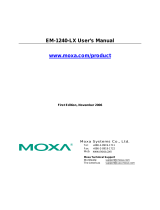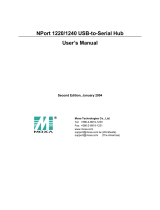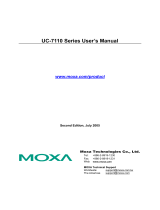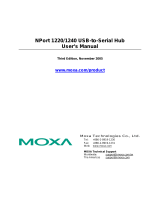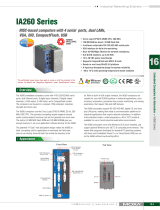Page is loading ...

— 1 — — 2 — — 3 —
EM-1240-LX
Quick Installation Guide
Third Edition, June 2008
1. Overview
Thank you for purchasing the Moxa EM-1240 Embedded Module. The
product’s features include 4 software-selectable RS-232/422/485 serial
ports, two 10/100 Mbps Ethernet ports, and SD signals for external SD
socket connections, based on the Moxa ARM9 32-bit 192 MHz
communication processor. These features make the EM-1240 ideal for
use as the core module of an industrial embedded system.
In addition, Moxa provides an EM-1240 Development Kit, which is
designed for system and software program development at the system
evaluation stage. The kit includes the EM-1240 embedded computer,
and the EM-1240-DK carrier board, which is used to evaluate the
EM-1240. The EM-1240’s pre-installed, ready-to-run μClinux Kernel
2.6 makes it easy for users to develop programs for any application.
2. Package Checklist
Before installing the EM-1240 Development Kit, verify that the
package contains the following items:
y 1 EM-1240 Embedded Module
y 1 EM-1240-DK (the carrier board of the EM-1240 Development Kit)
y Quick Installation Guide
y Document & Software CD
y Cross-over Ethernet cable
y Universal Power Adaptor
y Product Warranty Statement
Please notify your sales representative if any of the above items are
missing or damaged.
3. Product Features
y Moxa ART ARM9 32-bit 192 MHz communication processor
y 16 MB RAM, 8 MB Flash ROM on the board
y 4 software-selectable RS-232/422/485 serial ports
y Dual 10/100 Mbps Ethernet ports
y RS-232 console port (supports full signal and PPP)
y Ready-to-Run μClinux Kernel 2.6.9 communication platform
y SD signals supported for external Secure Digital (SD) socket
connection
y 10 GPIO reserved for system integration (NOTE: To enable GPIO,
SD must first be disabled)
4. Hardware Introduction
EM-1240 Embedded Module View
Top View Bottom View
EM-1240-DK View
5. Combining Embedded Module with EM-1240-DK
Insert the EM-1240 embedded module vertically onto the Development
Kit board. Note that the pin marked “JP4” on the embedded module
must be matched with the pin marked “JP6” on the Development Kit;
the pin marked “JP3” on the embedded module must be matched with
the pin marked “JP4” on the development kit. Use caution when
combining the boards, since improper handling could damage the
boards’ pins.
6. EM-1240-DK Introduction
LED Indicators
LED Name Color LED Function
Power Green Power is on.
Ready Green Power is on and system functions normally.
Green Serial port 1-4 is transmitting data.
P1-P4 (Tx)
Off Serial port 1-4 is not transmitting data.
Yellow Serial port 1-4 is receiving data.
P1-P4 (Rx)
Off Serial port 1-4 is not receiving data.
Serial Ports
The EM-1240 embedded module offers 4 software-selectable serial
ports. The software that comes with the product can be used to
configure these ports. Detailed information is provided in the Software
User’s Manual.
Male DB9 Port
54
321
9876
Pin Header
J1/J3/J4/J6
1
2
3
4
5
6
7
8
DCD
RxD
TxD
DTR
GND
DSR
RTS
CTS
Pin RS-232 RS-422
4-wire
RS-485
2-wire
RS-485
1 DCD TxDA(-) TxDA(-) ---
2 RxD TxDB(+) TxDB(+) ---
3 TxD RxDB(+) RxDB(+) DataB(+)
4 DTR RxDA(-) RxDA(-) DataA(-)
5 GND GND GND GND
6 DSR --- --- ---
7 RTS --- --- ---
8 CTS --- --- ---
Console Ports
The EM-1240 embedded module has 1 serial console port for onsite
configuration. However, it can also be used as an RS-232 serial port.
Detailed information is provided in the Software User’s Manual.
P/N: 1802012400012

— 4 — — 5 — — 6 —
Male DB9 Port J5 Console Port
54
32
1
9876
1
LAN Ports
The EM-1240 embedded module has 2 LAN ports that support 10/100
Mbps. The communication redundancy provided by the 2 LAN ports is
useful for avoiding network failure.
8-pin RJ45
81
81
Pin Signal
1 ETx+
2 ETx-
3 ERx+
4 ---
5 ---
6 ERx-
7 ---
8 ---
SD Socket
The EM-1240 Development Kit has an internal SD socket for storage
expansion. The SD socket allows users to plug in a Secure Digital (SD)
memory card that is compliant with the SD 1.0 standard to provide up
to 1 GB of additional memory space. When removing the SD card from
the socket, press in the SD card first to cause it to pop out. Detailed
information is provided in the Software User’s Manual.
GPIO
The EM-1240 Development Kit has 10 GPIOs. Digital input channels
and digital output channels can be configured by software. Note that
the GPIO function will not work if you enable the SD signals. Use the
GPIO pin header to connect to devices. The GPIO pinouts are shown in
the following figure.
01
11
2
1
31
4
1
C
CV
CCV
Connecting the Power
You may use either 5 VAC power or use the terminal block to provide
power. Use the power switch to turn on and turn off the Development
Kit.
Reset Button
Press the Reset button on the EM-1240-DK continuously for at least 5
seconds to load the factory default configuration. After the factory
default configuration has been loaded, the system will reboot
automatically. We recommend that you only use this function if the
software is not working properly and you want to load factory default
settings. To reset an embedded Linux system, always use the software
reboot command />reboot to protect the integrity of data being
transmitted or processed. The Reset button is not designed to hard
reboot the EM-1240 Development Kit.
7. Software Installation Procedure
STEP 1: Insert the EM-1240 CD-ROM into your Windows or Linux PC.
Use Acrobat Reader to view the EM-1240 User’s Manual.
STEP 2: Install the EM-1240 tool chain, which is on the CD-ROM. The
tool chain consists of the following components:
1. UC Finder: Broadcast search for the EM-1240 IP address on
your LAN. The EM-1240 supports the Linux platform.
2. Cross Compiler: Arm-elf-gcc is a C/C++ PC Cross
Compiler, which is a gcc compiler that runs on an x86 PC, but
creates an execution file for Arm-based platforms (such as the
EM-1240). For more information visit http://www.uclinux.org
.
3. uClibc: uClibc is an abbreviation for “microcontroller C
library.” uClibc was created to support µClinux, a Linux port
for MMU-less microcontrollers, such as the ARM9 installed in
the EM-1240. For more information, visit
http://www.uclibc.org
.
STEP 3: Edit source code on a Linux PC.
STEP 4: Use the Cross Compiler to compile the source code, and then
use FTP to download the program to the EM-1240.
STEP 5: Run your program.
8. EM-1240 Hardware Specifications
Model
EM-1240 Embedded Module
CPU
Moxa ART ARM9 32-bit 192 MHz processor
RAM
16 MB
Flash
8 MB
LAN
Auto-sensing 10/100 Mbps × 2
Built-in 1.5 KV magnetic isolation
Serial Ports
4 serial ports that support RS-232/422/485
signals
RS-232: TxD, RxD, DTR, DSR, RTS, CTS, DCD,
GND
RS-422: TxD+, TxD-, RxD+, RxD-, GND
4-wire RS-485: TxD+, TxD-, RxD+, RxD-, GND
2-wire RS-485: Data+, Data-, GND
Serial Protection: 15 KV ESD for all signals
Data bits: 5, 6, 7, 8
Stop bits: 1, 1.5, 2
Parity: None, even, odd, space, mark
Flow Control: RTC/CTS, XON/XOFF
Speed: 50 bps to 921.6 Kbps, support any baudrate
Serial Console
RS-232 × 1 (supports full signals and PPP)
Storage Expansion
SD signals for external Secure Digital (SD)
socket connection
GPIO
GPIO × 10 (to enable GPIO, SD must be
disabled)
Real-time Clock
Yes
Watchdog Timer
Yes
Buzzer Signals
Buzzer signals reserved for external buzzer
connection
LED Signals
System: Ready × 1
LAN: 10M/Link × 2, 100M/Link × 2
Serial: TxD × 4, RxD × 4
Reset Signal
Reserve signal for external “Reset to Default”
button connection
Power Input
Accept external 5 VDC through pin header
Dimensions (W × L)
90 × 80 mm
Operating Temperature
-10 to 60
◦
C (14 to 141
◦
F), 5 to 95% RH
Storage Temperature
-20 to 80
◦
C (-4 to 176
◦
F), 5 to 95% RH
Module Interface
Two 2 × 28 pin-headers,
pitch: 1.27 × 1.27 (mm)
Click here for online support:
www.moxa.com/support
The Americas: +1-714-528-6777 (toll-free: 1-888-669-2872)
Europe: +49-89-3 70 03 99-0
Asia-Pacific: +886-2-8919-1230
China: +86-21-5258-9955 (toll-free: 800-820-5036)
© 2008 Moxa Inc., all rights reserved.
Reproduction without permission is prohibited.
/

